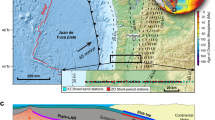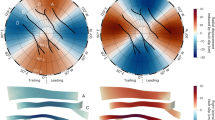Abstract
The eruptive activity at the neighbouring Hawaiian volcanoes, Kīlauea and Mauna Loa, is thought to be linked1,2,3, despite both having separate lithospheric magmatic plumbing systems. Over the past century, activity at the two volcanoes has been anti-correlated, which could reflect a competition for the same magma supply1,2. Yet, during the past decade Kīlauea and Mauna Loa have inflated simultaneously3. Linked activity between adjacent volcanoes in general remains controversial4,5,6. Here we present a numerical model for the dynamical interaction between Kīlauea and Mauna Loa, where both volcanoes are coupled by pore-pressure diffusion, occurring within a common, asthenospheric magma supply system. The model is constrained by measurements of gas emission rates7,8, indicative of eruptive activity, and it is calibrated to match geodetic measurements of surface deformation at both volcanoes, inferred to reflect changes in shallow magma storage. Although an increase in the asthenospheric magma supply can cause simultaneous inflation of Kīlauea and Mauna Loa, we find that eruptive activity at one volcano may inhibit eruptions of the adjacent volcano, if there is no concurrent increase in magma supply. We conclude that dynamic stress transfer by asthenospheric pore pressure is a viable mechanism for volcano coupling at Hawai‘i, and perhaps for adjacent volcanoes elsewhere.
This is a preview of subscription content, access via your institution
Access options
Subscribe to this journal
Receive 12 print issues and online access
$259.00 per year
only $21.58 per issue
Buy this article
- Purchase on Springer Link
- Instant access to full article PDF
Prices may be subject to local taxes which are calculated during checkout



Similar content being viewed by others
References
Klein, F. W. Patterns of historical eruptions at Hawaiian volcanoes. J. Volcanol. Geotherm. Res. 12, 1–35 (1982).
Bebbington, M. Incorporating the eruptive history in a stochastic model for volcanic eruptions. J. Volcanol. Geotherm. Res. 175, 325–333 (2008).
Miklius, A. & Cervelli, P. Interaction between Kīlauea and Mauna Loa. Nature 421, 229 (2003).
Linde, A. T. & Sacks, I. S. Triggering of volcanic eruptions. Nature 395, 888–890 (1998).
Manga, M. & Brodsky, E. Seismic triggering of eruptions in the far field: Volcanoes and geysers. Annu. Rev. Earth Planet. Sci. 34, 263–291 (2006).
Palladino, D. M. & Sottili, G. On the space-time distribution of major explosive volcanic eruptions on Earth. Geophys. Res. Lett. 39, L12308 (2012).
Elias, T. & Sutton, A. J. Sulfur Dioxide Emission Rates from Kīlauea Volcano, Hawai‘i, An Update: 2002–2006 US Geol. Surv. Open-File Rept 2007-1114, pubs.usgs.gov/of/2007/1114 (2007).
Elias, T. & Sutton, A. J. Sulfur Dioxide Emission Rates from Kīlauea Volcano, Hawai‘i, 2007–2010 US Geol. Surv. Open-File Rept. 2012-1107, pubs.usgs.gov/of/2012/1107 (2012).
Sturkell, E. et al. in The Mýrdalsjökull Ice Cap, Iceland—Glacial Processes, Sediments And Landforms On An Active Volcano (eds Schomacker, A., Krüger, J. & Kjær, K. H.) Ch. 2, 5–21 (Developments in Quaternary Science, Vol. 13, Elsevier, 2009).
Steacy, S., Gomberg, J. & Cocco, M. Introduction to special section: Stress transfer, earthquake triggering, and time-dependent seismic hazard. J. Geophys. Res. 110, B05S01 (2005).
DePaolo, D. J. & Stolper, E. M. Models of Hawaiian volcano growth and plume structure: Implications of results from the Hawaii Scientific Drilling Project. J. Geophys. Res. 101, 11643–11654 (1996).
McKenzie, D. The generation and compaction of partially molten rock. J. Petrol. 25, 713–765 (1984).
Maaløe, S. Magma accumulation in Hawaiian plume sources. Am. J. Sci. 299, 139–156 (1999).
Schmerr, N. The Gutenberg discontinuity: Melt at the lithosphere–asthenosphere boundary. Science 335, 1480–1483 (2012).
Eaton, J. P. & Murata, K. J. How volcanoes grow. Science 132, 925–938 (1960).
Kohlstedt, D. L. & Holtzman, B. K. Shearing melt out of the Earth: An experimentalist’s perspective on the influence of deformation on melt extraction. Annu. Rev. Earth Planet. Sci. 37, 561–593 (2009).
Weis, D., Garcia, M. O., Rhodes, J. M., Jellinek, M. & Scoates, J. S. Role of the deep mantle in generating the compositional asymmetry of the Hawaiian mantle plume. Nature Geosci. 4, 831–838 (2011).
Okubo, P. G. & Wolfe, C. J. Swarms of similar long-period earthquakes in the mantle beneath Mauna Loa Volcano. J. Volcanol. Geotherm. Res. 178, 787–794 (2008).
Amelung, F., Yun, S-H., Walter, T. R., Segall, P. & Kim, S-W. Stress control of deep rift intrusion at Mauna Loa volcano, Hawaii. Science 316, 1026–1030 (2007).
Poland, M. P., Sutton, A. J. & Gerlach, T. M. Magma degassing triggered by static decompression at Kīlauea Volcano, Hawai‘i. Geophys. Res. Lett. 36, L16306 (2009).
Cayol, V., Dieterich, J. H., Okamura, A. T. & Miklius, A. High magma storage rates before the 1983 eruption of Kīlauea, Hawaii. Science 288, 2343–2346 (2000).
Poland, M., Miklius, A., Sutton, J. & Thornber, C. A mantle-driven surge in magma supply to Kīlauea volcano during 2003–2007. Nature Geosci. 5, 295–300 (2012).
Wang, H. F. Theory of Linear Poroelasticity with Applications to Geomechanics and Hydrogeology (Princeton Univ. Press, 2000).
Sutton, A., Elias, T. & Kauahikaua, J. in The Pu‘u ‘Ō‘ō-Kupaianaha Eruption of Kīlauea Volcano, Hawai‘i: The First 20 Years (eds Heliker, C., Swanson, D. A. & Takahashi, T. J.) 137–148 (US Geol. Surv. Prof. Pap. Vol. 1676, US Geol. Surv. Prof. Pap., 2003).
Cervelli, P. F. & Miklius, A. in The Pu‘u ‘Ō‘ō-Kūpaianaha Eruption of Kīlauea Volcano, Hawai‘i: The First 20 Years (eds Heliker, C., Swanson, D. A. & Takahashi, T. J.) Ch. 9, 149–163 (US Geol. Surv. Prof. Pap. Vol. 1676, 2003).
Gerlach, T. M. Carbon dioxide emission rate of Kīlauea Volcano: Implications for primary magma and the summit reservoir. J. Geophys. Res. 107, 2189–2203 (2002).
Sims, K. W. W. et al. Porosity of the melting zone and variations in the solid mantle upwelling rate beneath Hawaii: Inferences from 238U–230Th–226Ra and 235U–231Pa disequilibria. Geochim. Cosmochim. Acta 63, 4119–4138 (1999).
Decker, R. W., Klein, F. W., Okamura, A. T. & Okubo, P. G. in Mauna Loa Revealed: Structure, Composition, History, and Hazards (eds Rhodes, J. M. & Lockwood, J. P.) 337–348 (Am. Geophys. Union Geopys. Monogr. Vol. 92, 1995).
Tamura, Y., Tatsumi, Y., Zhao, D., Kido, Y. & Shukuno, H. Hot fingers in the mantle wedge: New insights into magma genesis in subduction zones. Earth Planet. Sci. Lett 197, 105–116 (2002).
Allen, R. et al. Plume-driven plumbing and crustal formation in Iceland. J. Geophys. Res. 107, 2163–2181 (2002).
Acknowledgements
The Kīlauea and Mauna Loa GPS networks are supported by grants from the USGS, NSF and NASA and operated in collaboration by the USGS, Stanford University and the Pacific GPS Facility at the University of Hawai‘i. The authors thank J. Sutton for providing access to the CO2 data and S.E. Ingebritsen for constructive comments. H.M.G. thanks A. M. Jellinek and T. Fournier for constructive discussions. This work was supported by the USGS and by the NSF Geophysics and Volcanology & Petrology programmes.
Author information
Authors and Affiliations
Contributions
All authors contributed to the design of this study; H.M.G. developed the model; H.M.G. led the writing of the paper; C.J.W. significantly contributed to the writing of the paper; M.P.’s knowledge about Mauna Loa and Kīlauea were of critical importance to the model development; B.B., J.F., M.P. and A.M. have been involved in installation of GPS stations and in data acquisition; J.F. analysed the GPS data and produced the GPS time series; M.P. and A.M. have been involved in daily monitoring of the eruptive activity.
Corresponding author
Ethics declarations
Competing interests
The authors declare no competing financial interests.
Supplementary information
Supplementary Information
Supplementary Information (PDF 3104 kb)
Rights and permissions
About this article
Cite this article
Gonnermann, H., Foster, J., Poland, M. et al. Coupling at Mauna Loa and Kīlauea by stress transfer in an asthenospheric melt layer. Nature Geosci 5, 826–829 (2012). https://doi.org/10.1038/ngeo1612
Received:
Accepted:
Published:
Issue Date:
DOI: https://doi.org/10.1038/ngeo1612
This article is cited by
-
Combining thermal, tri-stereo optical and bi-static InSAR satellite imagery for lava volume estimates: the 2021 Cumbre Vieja eruption, La Palma
Scientific Reports (2023)
-
Elastic interaction between Mauna Loa and Kīlauea evidenced by independent component analysis
Scientific Reports (2022)
-
Thermal remote sensing reveals communication between volcanoes of the Klyuchevskoy Volcanic Group
Scientific Reports (2021)
-
Possible deep connection between volcanic systems evidenced by sequential assimilation of geodetic data
Scientific Reports (2018)
-
Geodetic evidence for interconnectivity between Aira and Kirishima magmatic systems, Japan
Scientific Reports (2018)



